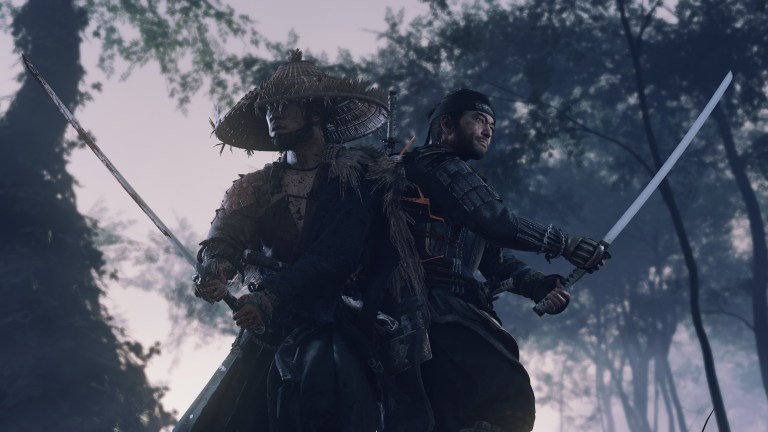Ghost of Tsushima Review: A Beautiful Homage to Akira Kurosawa
Ghost of Tsushima is a love letter to the classic samurai movies of Akira Kurosawa and one of the best games on the PlayStation 4.

Ghost of Tsushima is a daring departure for Sucker Punch, who since 2009 has worked solely on the Playstation-exclusive Infamous series. While those games were steeped in modernity, offering sprawling cityscapes players could explore from top to bottom via superpowered “conduits” Cole MacGrath and Delsin Rowe, Ghost of Tsushima’s open world is set in feudal Japan. It’s here that we meet young samurai Jin Sakai, who must defend his homeland, the titular island of Tsushima, from an invading Mongol army.
Right off the bat, the shift in time period and milieu to 13th–century Japan is notable because Sucker Punch handles it so brilliantly, especially for the team’s first foray into the samurai genre. Japanese history and culture are woven into every single facet of the game so elegantly and organically that you’d think the team had been developing games set in feudal Japan for the past decade, not sci-fi superhero romps. More than anything, Ghost of Tsushima is a moving homage to Japan, its history, and its people.
The story opens with a massacre. A massive Mongol army, led by the cunning Khotun Khan, storms the beaches of Tsushima and is met by the island’s woefully outnumbered samurai contingent. When the leader of the samurai challenges Khotun to a one-on-one, fair fight, the Khan renounces the honorable gesture in gruesome fashion, literally setting the courageous samurai on fire in front of both armies. The rest of the samurai are obliterated on the beach, while Jin’s uncle, Lord Shimura, is taken prisoner by the Khan. Jin is also fatally wounded but is miraculously nursed back to health by a new ally, a thief named Yuna who needs his help in return.
These opening moments set the tone for the rest of the game. The philosophical conflict between honor and deception is the beating heart of the story and permeates the gameplay in riveting ways. As you fight to take back Tsushima from the Mongols, you can approach enemy encounters in two ways. You can choose to fight honorably, like a true samurai, and challenge enemies to a “standoff,” a quick-reflex mini-game of sorts in which you and one of the baddies face off one-on-one and see who flinches first before one of you slashes his blade through the other. You’ll then have to take on the rest of the enemies all at once, which is no easy task.
The other option is to fight like a “Ghost,” sneaking into enemy camps, killing the bad guys in their sleep, poisoning them, using intimidation tactics to scare them into fleeing battle. It’s an effective way of evening the odds between you and your foes, but it rails against everything the samurai stand for.
Countless games offer the player the option to approach combat either stealthily or head-on. This is far from a novel concept, and in this respect, the combat in Ghost of Tsushima offers little innovation. But what is innovative here is how Sucker Punch has taken the classic device of stealth vs. frontal assault and given it new life by expertly integrating it with the themes of the story.
Jin meets a handful of allies on his journey, each with their own multi-chapter story arcs that delve into their respective backstories. There’s sensei Ishikawa, a master archer whose protege has gone rogue and joined the Mongols. Lady Masako is a warrior and grandmother whose entire family was murdered by the Mongols, though she suspects they may have died after someone close to the family conspired with the enemy.
Each of the characters explores the honor vs. dishonor theme in unique and surprising ways. The dichotomy is most starkly represented in the clash of ideals between Lord Shimura, who is unshakably honorable and would rather die than gain an unfair advantage in battle, and Yuna, who understands that, to beat an enemy who fights dirty, you may have to put honor to the side for the sake of saving your people. Of course, Jin is caught in the middle and struggles to decide what kind of man he wants to be.
Aside from the ties to the story, the gameplay is fun and engaging. The swordplay combines parries and dodging with a more strategic approach to melee, as you try to find ways to build up your enemy’s stagger gauge. You can also use “ghost weapons” to give you an edge in battle, like kunai (throwing knives), smoke bombs, arrows, and more. There are also four stances to master, with each being effective against a different enemy type. Switching between stances is integral to combat and becomes second nature over time. There’s also an insanely cool fifth stance that I won’t spoil here, but it’s spectacularly badass.
Stealthing is strikingly similar to what you’d see in an Assassin’s Creed title (this is a compliment), and the game gives you myriad ways to kill enemies without raising alarms, like throwable wind chimes and firecrackers that allow you to manipulate their positioning or hallucinogenic darts that turn them against each other. Again, this is all stuff we’ve seen before, but it’s pulled off well here.
Release Date: July 17, 2020
Platform: PS4
Developer: Sucker Punch Productions
Publisher: Sony Interactive Entertainment
Genre: Action-adventure
Unfortunately, there are little gameplay flaws that needled at me, especially in the later hours of my playthrough (it took me around 45 hours to finish the game). The swordplay requires quick reflexes, and mastering parries and dodging is absolutely pivotal to your survival. The problem with the swordplay is subtle, and a little difficult to explain, but I’ll say it like this: in most games that are particularly challenging, when I die, I feel like it was my fault because I made a mistake, I just wasn’t fast enough, I hadn’t mastered certain skills. But on many occasions in Ghost of Tsushima, I felt like I died because the game didn’t give me a fair shot, like it was the game’s fault that I failed, not mine. It’s possible that I just wasn’t very good at the game, but it felt at times like I wasn’t given a choice in the matter. Your mileage will vary with the game’s difficulty level.
There are other things that bugged me, too, like the unreliable climbing mechanics (I swear, sometimes hopping onto a rope or branch that’s literally right in front of you is way, WAY too difficult). But overall, I had a great time playing the game and felt super powerful by the time I’d filled out my skill trees, which is no surprise considering the game was made by the same folks who made Infamous.
On a nuts and bolts gameplay level, Ghost of Tsushima doesn’t feel all that unique — there is some very familiar open-world stuff here. But on a presentation and storytelling level, the game is out-of-this-world amazing. Visually, the game looks stunning. The late-stage PlayStation 4 graphics really deliver, and coupled with the strength of the art design, Ghost of Tsushima is a true head-turner. The character models look fantastic and can emote on a level that supports the drama of the story. And while the different suits of armor that Jin acquires offer unique gameplay perks, I honestly just collected and upgraded them almost exclusively as an aesthetic indulgence. They look so freaking cool.
But the real stars of the show are the environments, which look picturesque from every conceivable angle. The wind-swept, verdant hills of Tsushima are intoxicatingly pretty, to the point where I’d get caught up ogling for minutes on end at the smallest of details, like the way the moonlight bounces off blades of grass or the way Jin kicks up crimson-red leaves that have blanketed the ground over time. I could go on forever about the dynamic day/night cycle, the beautiful rendering of different fabrics and materials, the horse animations. But instead, I’ll just say that this is the most breathtaking game, visually, that I’ve seen in recent memory.
A lot of love also went into infusing the game with Japanese cultural references, particularly in how the developers pay homage to the samurai genre. Each mission, for example, is bookended by cinematic intertitles that evoke old samurai cinema, Japanese characters, and all. But without a doubt, the most obvious/most amazing homage is “Kurosawa Mode,” which presents the game in black and white, with one of the best film grain filters I’ve ever seen in a game, resulting in an experience that looks almost exactly like a film from the iconic Japanese auteur’s oeuvre, right next to Sanjuro and Seven Samurai. If you’re a long-time fan of Kurosawa, turning the mode on may even elicit an “I’m not crying…you’re crying!” response — it’s that pretty.
I initially intended on playing the entire game in Kurosawa mode but quickly realized that it would be problematic to do so for a few reasons. Some missions require you to “follow the (insert color) flowers,” which is obviously impossible in black and white. And in combat, blockable enemy heavy attacks are signaled by a blue glint, while unblockable ones have a red glint. Combat is tough enough as it is, so…yeah. I only turned the mode on when I was riding on my horse through the countryside and I felt like treating myself to some eye candy.
Taking time to smell the cherry blossoms and have a respite from the game’s many missions and side missions is crucial because Ghost of Tsushima is a long, long game. The missions aren’t overly repetitive — most of them feel really special actually, like when you climb a mountain in freezing cold weather and must race from campfire to campfire on your ascent, or one armor quest comprised of several one-on-one duels with straw hat swordsmen scattered about the map, each with a distinct personality. But 40-plus hours is 40-plus hours, and while the main tasks of infiltrating enemy camps, liberating farms, and searching for special gear can lead to questing fatigue at the tail end of the game, the nice thing is is that you can always slow things down and just enjoy the scenery to break things up. There’s even a nifty photo mode to play with, and if any game warrants a photo mode, it’s this one.
Jin’s story isn’t just a means to an end, or a lazy excuse to drag the player from gameplay scenario to gameplay scenario. The story is incredibly well written and profound in its messaging and imagery, so much so that I believe it’s one of the best modern entries in the samurai genre, regardless of medium. All of the characters you meet and the little tales that unfold across Tsushima are filtered through Jin’s inner struggle with what honor really means and whether or not it’s worth dying for, which gives the story an incredibly strong narrative backbone. Despite the game’s epic scope, Jin’s journey actually feels quite intimate and personal. The same could be said of Kurosawa’s best work, and that’s just about the highest compliment I can give.
